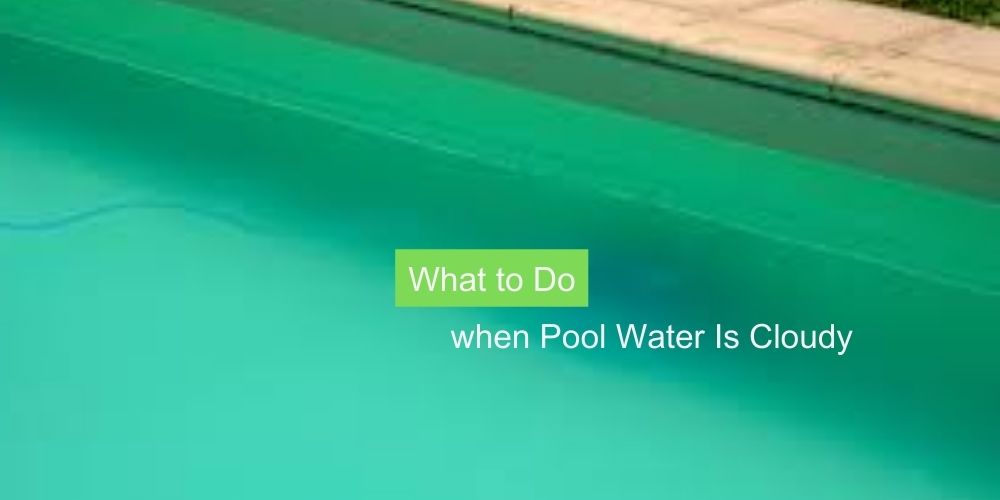
Clear pool water is not only visually appealing but also essential for a safe and enjoyable swimming experience. However, sometimes our pools can become cloudy, causing concern. Understanding the importance of clear pool water and the common causes of cloudiness will help us restore its pristine condition. In this blog, we’ll explore the significance of maintaining clear pool water and identify the factors leading to cloudiness, enabling us to take appropriate steps for a crystal-clear pool all season long. Let’s dive in and discover what to do when pool water becomes cloudy.
What to Do when Pool Water Is Cloudy

Cloudy pool water can result from imbalanced water chemistry, insufficient filtration, and the presence of organic matter and debris.
- Imbalanced water chemistry: pH levels, total alkalinity, and chlorine levels can impact water clarity.
- Insufficient filtration and circulation: Proper filtration and water circulation are crucial for preventing cloudiness.
- Presence of organic matter and debris: Leaves and dirt can contribute to cloudy water.
To address the issue, visually inspect the pool, conduct water tests, and identify potential causes for cloudiness.
- Visual examination: Look for haziness, discoloration, and floating debris.
- Water testing: Use a pool water testing kit to check pH, alkalinity, and chlorine levels.
- Identifying potential causes: Based on the inspection and test results, pinpoint the likely reasons for cloudiness.
By understanding the causes and assessing the situation, you can take appropriate actions to restore your pool’s clarity and maintain a sparkling swimming oasis.
Steps to Clear Cloudy Pool Water
Cloudy pool water can be a frustrating problem, but with the right approach, you can restore its clarity and enjoy a pristine swimming experience. Here are the essential steps to clear cloudy pool water:
1. Adjusting water chemistry:
i) Balancing pH levels: Test the pH of your pool water and adjust it to the recommended range (usually between 7.2 and 7.6). Adding pH increaser or pH decreaser will help bring the pH to the optimal level, ensuring water clarity.
ii) Adjusting total alkalinity: Total alkalinity acts as a buffer for pH. If it’s too high or too low, it can affect water clarity. Use alkalinity increaser or decreaser to bring it within the appropriate range (typically between 80 and 120 parts per million).
iii) Maintaining proper chlorine levels: Ensure that your pool has adequate chlorine levels to eliminate contaminants and prevent the growth of algae and bacteria. Test the chlorine levels regularly and adjust them as needed using chlorine tablets, granules, or liquid chlorine.
2. Improving filtration and circulation:
i) Cleaning the filter: A dirty or clogged filter can hinder proper water filtration. Clean or backwash your filter according to the manufacturer’s instructions. This will remove debris and contaminants, allowing for efficient filtration.
ii) Running the pump and filter for longer periods: Increase the duration of your pump and filter operation. Longer filtration cycles help remove suspended particles and maintain water clarity. Aim for at least 8 to 10 hours of daily filtration, or more if needed.
iii) Ensuring adequate water circulation: Proper water circulation is essential for distributing chemicals evenly and preventing stagnation. Check that all return jets are functioning correctly and adjust them if necessary to promote efficient circulation.
3. Removing organic matter and debris:
i) Skimming the surface: Use a pool skimmer or net to remove leaves, insects, and other debris floating on the water surface. Regular skimming prevents them from sinking and contributing to cloudiness.
ii) Vacuuming the pool: Vacuum the pool floor and walls to remove settled debris and dirt. Use a pool vacuum cleaner or an automatic pool cleaner for more efficient cleaning.
iii) Shocking the pool: Pool shocking involves adding a high dose of chlorine or a non-chlorine shock treatment to eliminate contaminants and restore water clarity. Follow the product instructions carefully when shocking your pool.
By following these steps and addressing the specific areas of concern, you can effectively clear cloudy pool water and maintain a sparkling, inviting swimming environment. In the next section, we will discuss the importance of prevention and regular maintenance to keep your pool water crystal clear.
Prevention and Maintenance
Clearing cloudy pool water is essential, but it’s even better to prevent cloudiness from occurring in the first place. By establishing a proactive maintenance routine, you can keep your pool water crystal clear throughout the swimming season. Here are some key prevention and maintenance practices to implement:
- Regular water testing and chemical adjustments: Test your pool water regularly, ideally at least once a week, to ensure proper chemical balance. Monitor pH levels, total alkalinity, and chlorine levels to maintain optimal conditions. Make necessary adjustments using appropriate chemicals to keep the water chemistry in check.
- Proper maintenance of the filtration system: Your pool’s filtration system plays a vital role in keeping the water clean and clear. Follow the manufacturer’s instructions for maintenance and cleaning. Regularly inspect and clean or replace the filter cartridges as needed. Ensure that the system is running efficiently to maintain effective water circulation and filtration.
- Regular cleaning and skimming of the pool: Prevention starts with regular cleaning. Skim the pool’s surface daily to remove leaves, bugs, and debris. Use a pool net or skimmer to keep the water clear of visible contaminants. Additionally, brush the pool walls and floor weekly to prevent the buildup of algae and other organic matter.
- Promoting good hygiene practices: Encourage pool users to practice good hygiene to minimize the introduction of contaminants. This includes showering before entering the pool, using the restroom facilities, and avoiding swimming with open wounds or illnesses. Remind swimmers to avoid introducing oils, lotions, and excessive sunscreen into the pool, as these can contribute to water cloudiness.
Final Thoughts
Prompt action is crucial when dealing with cloudy pool water. Understanding the causes and taking appropriate steps, such as adjusting water chemistry, improving filtration and circulation, and removing organic matter, can restore clarity. Prevention and maintenance, including regular water testing, proper filtration system maintenance, cleaning, and promoting good hygiene, help maintain a clear and inviting pool environment. By following these steps, you can enjoy a consistently clean pool and create lasting memories in your backyard oasis.

Hi, This is Josh. I am a former competitive swimmer and current fitness enthusiast.
I created this site to share my love of swimming with the world!
